

| Film: | Sharpe’s Rifles |
| Year: | 1808 |
| Rank: | Sergeant |
| Promoted: | 2nd Lieutenant (1st Lieutenant at end of movie) |
| Position: | Commander of the Sharpshooters, 2nd Battalion, 95th Rifle Corps |
| Film: | Sharpe’s Eagle |
| Year: | 1808 |
| Rank: | 1st Lieutenant |
| Promoted: | Captain |
| Position: | Commander of the Light Company, The South Essex Regiment, but maintained his Rifles uniform |
| Film: | Sharpe’s Company |
| Year: | 1812 |
| Rank: | Captain, reduced to 1st Lieutenant, then back to Captain |
| Position: | Temporary Quartermaster; Commander of the Light Company, The South Essex Regiment, continued wearing his Rifles uniform |
| Film: | Sharpe’s Enemy |
| Year: | 1813 |
| Rank: | Promoted to Major |
| Position: | On detachment from The South Essex Regiment, continued wearing his Rifles uniform |
| Film: | Sharpe’s Regiment |
| Year: | 1813 |
| Rank: | Major. First appearance in Dress Uniform |
| Position: | Commander, First Battalion, The South Essex Regiment, continued wearing his Rifles uniform |
| Film: | Sharpe’s Waterloo |
| Year: | 1815 |
| Rank: | Lt. Colonel/td> |
| Position: | Staff Officer, 5th (Belgian) Light Dragoons, continued wearing his Rifles uniform |
The 95th Regiment of Foot or Rifle Corps was raised in 1800 and numbered 95th in 1803. As an active officer of the Rifle Corps or Rifles, Sharpe is mainly seen in the service uniform which gets modified when he is on campaign. The uniforms were of green cloth and their accoutrement silver and black.
The nickname of the 95th were “Rifles” because of their weapons in a time when muskets were the main choice of fire-arm in European armies or “The Sweeps” derived from the somber green, so dark that they resembled chimney sweeps. Once on the Peninsula, they quickly became known to the French as the Grasshoppers.
In the Sharpe’s Rifles film episode, Sharpe is raised to Lieutenant and an officer’s uniform obtained for him by Maj. Hogan. It was already missing braid, buttons and had a hole in the left elbow. Sharpe wears his hair cut short for in 1808 the queue and powdering of hair had been abolished.
Madeira Bay, Portugal 20th August 1808:
"The new arrivals (1/95th) brought most welcome news for every man in the
British Army: by an order dated 20th July 1808, powdered hair and queues were
abolished. Within a short time, there was probably not a queue left in Wellesley's
army. Captain Dobb's of the 52nd Foot noted, 'the men had great joy, for they
were relieved from hair-tying, which was an operation grievous to be borne'."
Osprey
Books, Vimero, 2001 (Pg. 63)
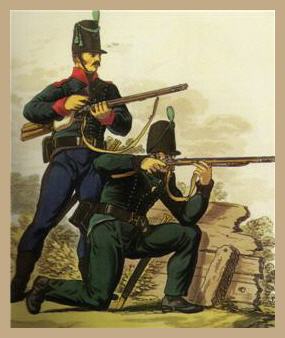
To date, there are no surviving examples of uniforms of the Rank and File of the 95th Rifles. Only one example of an Officer’s service uniform survived and currently resides in the Royal Green Jackets Museum in Winchester, United Kingdom. http://www.rgjmuseum.co.uk/home.asp
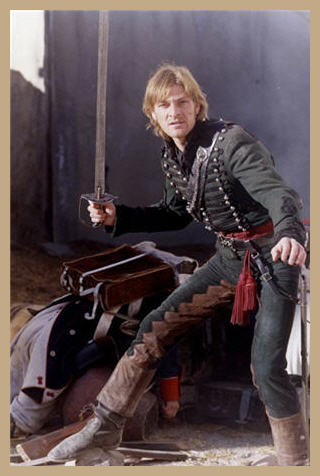
The Undress or Service Uniform for Offrs. of the Rifle Corps to be a Jacket of dark Green Cloth, without Lappels or Skirts, and made to Button over the Body down to the waist. The Breast fronted with Green Cloth, lined with Green Silk or Shalloon (a lightweight twilled fabric named for the town in France that produced it in the 17th C, Chalons-sur-Marne.). A Black Velvet Standing Collar lined with Green Cloth. Cuffs Black Velvet 2 ½ Inches in Breadth, pointed and to open with 5 buttons. A Double Row of Buttons on one Front and a single Row with Button Holes on the Other. 22 Buttons in each Row and the same number of Looping of Black Silk Twist on each Front between the Rows with a Knot on the Outer Side; the Looping 7 ½ Inches in length at the Top and reduced gradually to 2 ½ inches a the Bottom, and in which Forms the Buttons are set on. A Loop of Twist on each Front of the Collar, a Row of the Same down the Seams from the Shoulders to the Hip Buttons, and a double Row on the Fronts instead of Pocket Welts. Black Velvet Wings and Straps with Bullion and Fringe, besides a Silver Chain on the Wings and Straps. The Buttons throughout of a round form like a Ball and set on at Equal Distances. The Lace and Epaulettes Silver. (Service or Undress Uniforms of Officer of Rifle Corps. 1802 Clothing Regulations (Para 23B.))
Green Trousers: The regulations prescribed dark green pantaloons with a row of black twist down the seams, black linen gaiters with black buttons and small stiff tops, black garters and uniform buckles with Half Boots. One of Sharpe's eccentricities was that he wore looted French cavalry overalls with leather reinforcements down the inner legs. His boots were also looted from the French.
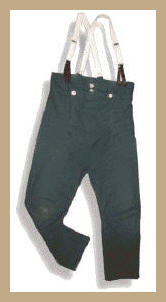
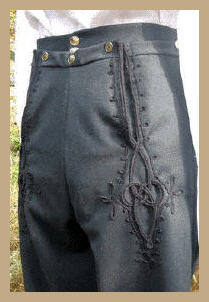
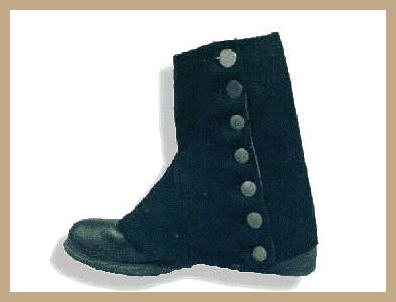
Boots at the time were straight shoes, made for either foot and men were recommended to change them from foot to foot to even the wear, although officers who could afford it could have shoes made for them that fitted each foot.
Around his neck he would wear a black silk stock knotted at the neck and covering the collar of his linen shirt. On his head, he would wear a shako like his men, often called the “stovepipe” for its cylindrical shape. These were green with Green Feathers and a Silver Crown and Bugle engraved on the Right Side of the Helmet, with a Green Cord round the Cap. (Felt Caps. 1802 Clothing Regulations (para 55.) The Serjeant and Buglers to wear Green Feathers, the Rank and File and Armourers a Green Tuft similar to Light Infantry.) As an officer, Sharpe would not wear a forage cap. The forage cap was only worn by the rank and file. A soft woolen cap with white piping, the forage cap was only worn from sun-down to sun-rise.

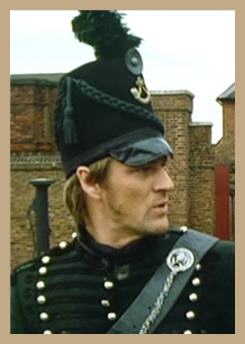
A sword, a sash, epaulletes, a shoulder belt where their whistle (used for communication) would hang, and a pistol completed the Officer’s service uniform ensemble.
The sword of the Rifle Corps was a curved Sabre similar to Light Cavalry, with the Sword Knot to be Crimson and Gold in stripes (Swords, Sword Knots and Belts. 1802 Clothing Regulations (Para 34A)). Sharpe however, preferred the straight 1796 pattern Heavy Calvary sword given to him by Captain Murray in Sharpe’s Rifles which he wore without a Sword Knot and used like bludgeon.
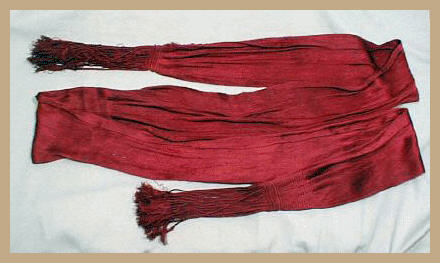
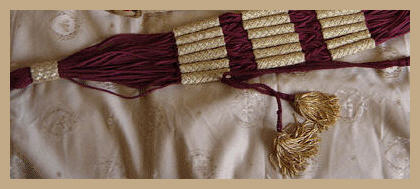
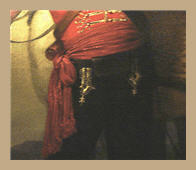
The Sash: a sprang woven silk sash in crimson worn over the coat, around the waist and long enough to go around twice, knotted on the right with tail and ends hanging down. Later in the war, some officers adopted the barrel sash that fashionable cavalry officers wore. Several examples reside in the RGJ Museum of light infantry sashes, including the one belonging to Col. Coote Manningham. From the begining, Sharpe's sashes tended to be of the long-corded tasselled style and the knot tended to move from side to side from episode to episode, sometimes moving around in the same episode. In Sharpe's Regiment, when he acquired his new dress uniform, he wore it with the standard Light Infantry-style sash made of sprang woven silk. In the later India episodes, Sharpe’s sash is held closed with hooks while maintaining the appearance of a long-corded, tasselled sprang-woven silk sash.

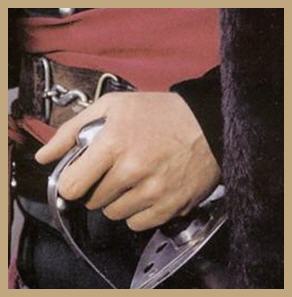
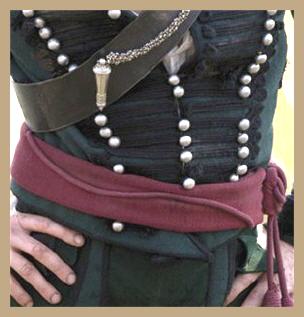
Uniform regulations stated that a single epaulette made of Silver Embroidery of Lace with rich Bullion and Fringe was worn on the right shoulder with an Embroidered Bugle Horn on the broad end of the strap by Lieutenants and Captains. Majors wore epaulets on both shoulders. However, there is no evidence to show that Rifles officers wore any epaulets on campaign and Sharpe does not wear any.
Officers of the Rifle Corps besides their Swords are to carry a small Pistol in a Pouch worn with a Black Leather Belt across the left Shoulder, the Flap of the Pouch ornamented with a Silver Lion’s Head and a Chain with a Green Ivory Whistle on the Front the Belt at the Breast. 1802 Clothing Regulations (Para 35B)
Sharpe did eventually carry a pistol, but not until Sharpe's Justice and the model was never mentioned. His whistle was silver, attached to a chain draped from a Silver Lion's Head across his breast belt. Ivory was difficult to find and delicate compared to metal. Most examples of whistles that have survived are metal. Riflemen did not wear epaulets or gorgets at all, unless in court dress.
Effective Field Officers and Adjutants who are to be on Horseback not to wear Gorgets. It is supposed neither do the Officers of Rifle Corps or Light Infantry. (Gorgets. 1802 Clothing Regulations D. (Para 36B) crossed out in pencil and noted “I do not recollect any Regulation which exempts these Officers from wearing Gorgets.”)
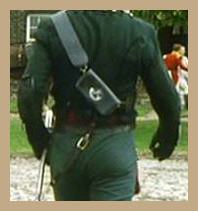
Unusual among officers, Sharpe also carried his Rifle and until he obtained his Model 1796 Heavy Cavalry Sword, he carried his Sword Bayonet. As an enlisted man he would have worn an ammunition pouch or ball bag on his waist belt. Once commissioned, his cartridge pouch was worn on the shoulder belt in the middle of his back. Both Sharpe and Capt. Frederickson can be seen in the series wearing it in the middle of their backs. Although regulations mention that the flap of the pouch was un-ornamented, the pouches seen in Sharpe were marked with the Rifles buglehorn and crown insignia and examples in the RGJ museum indicate this was correct.
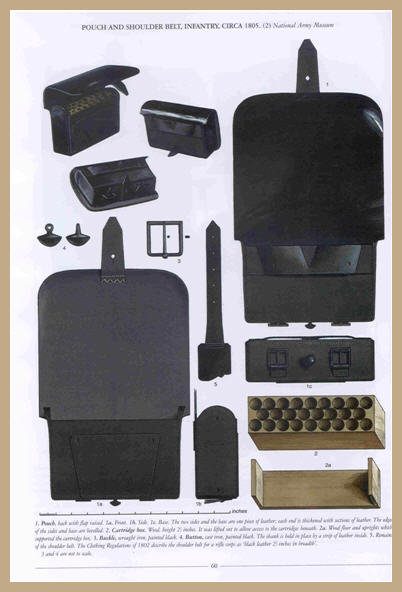
The Pouch for a Rifle Corps to have Wooden Box boxed for 12 Rounds, and another Tin capable of holding 24 rounds. The Flap of the Pouch without Ornaments and rounded at the Corners and fastened underneath with a Strap and Button.(1802 Clothing Regulations (Para 63A))
Baker Rifle: The Rifle Gun used by the 95th and Sharpe was manufactured by Ezekiel Baker and later known as the Baker Rifle. 8 inches shorter than the “Brown Bess” musket used by the rest of the infantry, the length was made up by the bayonet so as to present a uniform wall of bayonets when Riflemen were part of a square to repel cavalry. The sword bayonet was 23 inches long as compared to the 15 inch bayonet that was used with the musket. As they were effectively short swords and it simply follows that the Rifles called them swords and the regular command of “fix bayonets” was changed for Riflemen to “fix swords.”

Buttons. The 95th Rifle Corps had identifying buttons and the regulations called for a button with a raised Bugle Horn and Crown. Both officers and rank and file wore the same buttons except that the officers’ buttons were like to be made of silver rather than base metal. The one surviving jacket in the Royal Green Jackets Museum in Winchester has plain buttons, but we know from the regulations as well as the memoirs of Rifleman / Bugler William Green that they also had identifying buttons. "...one of our men, an habitual drunkard, could not march, he was so full of red port. So our Colonel had the Bugle-Major cut all the buttons off his jacket, that the French might not know what an honourable regiment he belonged to."(William Green, Where Duty Calls Me: Experiences of William Green of Lutterworth in the Napoleonic Wars (Synjon Books, 1975))
These buttons only came to light in the year 2003 when the re-enactors of the 2nd/95th (http://www.95th-rifles.co.uk/button.htm) happened to hear of someone who had found one.
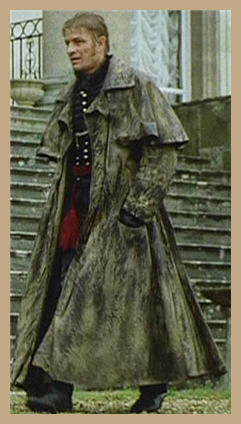
The Great Coat: In inclement weather, Sharpe would wear a great coat. Early on in the Penninsula Campaign, the weave was such that it could be easily wrung out and quickly dried when it got wet, but the Penninsula winters turned out to be much worse than anything ever anticipated and the wool weave had to be made much tighter to provide extra warmth and protection from the wind. Rudimentary waterproofing was applied by soldiers in the field whenever possible.
The Great Coat for Officers of a Rifle Corps are to be of dark Grey Cloth, double breasted, and with three Rows of Buttons, a falling Collar, Cuffs with Slits and 4 Small Buttons – The Collar and Cuffs of dark Green Cloth. The Pockets to in the Plait and the Buttons similar to the large size of the Full Dress Coat(1802 Clothing Regulations (Para 30))
The regulation gray wool coat is seen early in the series as he lays it over Teresa Moreno in Sharpe’s Rifles although the one often remembered is the brown/green camouflage-patterned one seen in Sharpe’s Revenge, Justice and Waterloo.
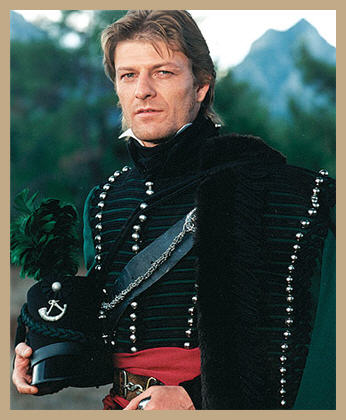
The Full Dress Uniform Coat for Offrs. of a Rifle Corps is to be of dark Green Cloth, long Skirts, and lined with White Shalloon, the Skirts turned back and fronted with White Cassimerei sewed down, and at the Joining a Circle of Black Velvet Embroidered with Silver. Lappel, Collar Cuffs and Wings Black Velvet. The Lappels, rather short and made to button across the Body at the 5th Button, 3 Inches in breadth at the Bottom, and increasing gradually to 3 ½ Inches at the Top. A Standing Collar faced with Green Cloth, which with the Cuffs are to be 3 Inches in Breadth. No Slits in the Cuffs. Cross Pocket Flaps. Ten Buttons on each Lappel, including one on Collar; Three on each Cuff and Pocket Flap. The Wings laced, and Bullion and Fringe besides Epaulettes. The Buttons set on at equal distances and all large excepting the Collar and Epaulettes. A flat plated Button with a raised Bugle Horn and Crown over it. (Full Dress Uniforms of Officer of Rifle Corps. 1802 Clothing Regulations (Para 23A.))
Sharpe however, did not wear the prescribed full Court Dress uniform when presented to the Prince of Wales in Sharpe’s Regiment. Instead, he wore a more formal version of the Service Uniform – a short jacket with more braiding, more buttons, a higher collar and a fur-trimmed pelisse, aping the cavalry style which was quite in fashion at the time. The pelisse is merely a fancier version of the tunic jacket with fur trimming, worn slung over the sword shoulder, pinned in place and probably held with a decorative chain as well. True to his nature, he maintained his purloined French Cavalry boots and his butcher's blade of a sword.
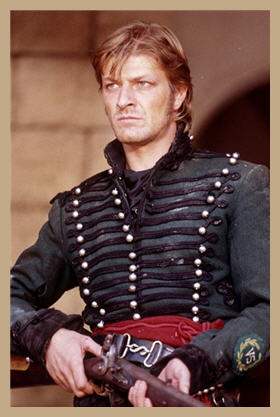
He had taken the wreath badge from his old jacket and insisted that the tailor sew it onto his brand new uniform. It felt odd to be dressed so finely, his waist circled by a tasselled red sash and his shoulder-wings bright with the stars of his rank. (Bernard Cornwell, Sharpe’s Regiment)
The Valiant Stormer badge was bestowed on Sharpe for the Siege of Badajoz as he unintentionally stepped into the role of leader of the Forlorn Hope when the storming of the fortress stalled and was, indeed, the first through the breach. It was that action that confirmed his Captaincy. The VS wreath badge is seen in several early pictures of Sharpe – through the first season, but the jacket was subsequently lost and the badge disappears from the later Sharpe seasons. It is not seen on his dress uniform worn in Sharpe’s Regiment when he is presented to the Prince of Wales, nor at his wedding to Jane Gibbons in Sharpe’s Siege.
Credits & Links:
With thanks to Ben Townsend and the 2nd/95th http://www.95th-rifles.co.uk/ for their kind assistance with historical references, photographs and discussion.
Baker Rifle: http://www.95th-rifles.co.uk/rifle_1.htm
Sword Bayonet: http://www.95th-rifles.co.uk/sword.htm
Knapsack & Contents: http://www.95th-rifles.co.uk/knapsack.htm
Pantaloons & Gaiter: http://www.95th-rifles.co.uk/
Officer's Pants: http://www.chimera-costumes.co.uk/
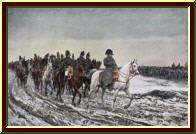 |
||||||
 |
 |
 |
 |
 |
||